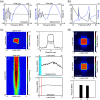Implantable acousto-optic window for monitoring ultrasound-mediated neuromodulation in vivo
- PMID: 35874142
- PMCID: PMC9298854
- DOI: 10.1117/1.NPh.9.3.032203
Implantable acousto-optic window for monitoring ultrasound-mediated neuromodulation in vivo
Abstract
Significance: Ultrasound has recently received considerable attention in neuroscience because it provides noninvasive control of deep brain activity. Although the feasibility of ultrasound stimulation has been reported in preclinical and clinical settings, its mechanistic understanding remains limited. While optical microscopy has become the "gold standard" tool for investigating population-level neural functions in vivo, its application for ultrasound neuromodulation has been technically challenging, as most conventional ultrasonic transducers are not designed to be compatible with optical microscopy. Aim: We aimed to develop a transparent acoustic transducer based on a glass coverslip called the acousto-optic window (AOW), which simultaneously provides ultrasound neuromodulation and microscopic monitoring of neural responses in vivo. Approach: The AOW was fabricated by the serial deposition of transparent acoustic stacks on a circular glass coverslip, comprising a piezoelectric material, polyvinylidene fluoride-trifluoroethylene, and indium-tin-oxide electrodes. The fabricated AOW was implanted into a transgenic neural-activity reporter mouse after open craniotomy. Two-photon microscopy was used to observe neuronal activity in response to ultrasonic stimulation through the AOW. Results: The AOW allowed microscopic imaging of calcium activity in cortical neurons in response to ultrasound stimulation. The optical transparency was over the visible and near-infrared spectra, and the ultrasonic pressure was 0.035 MPa at 10 MHz corresponding to . In anesthetized Gad2-GCaMP6-tdTomato mice, we observed robust ultrasound-evoked activation of inhibitory cortical neurons at depths up to . Conclusions: The AOW is an implantable ultrasonic transducer that is broadly compatible with optical imaging modalities. The AOW will facilitate our understanding of ultrasound neuromodulation in vivo.
Keywords: in vivo two-photon; neuromodulation; ultrasound.
© 2022 The Authors.
Figures




Similar articles
-
An Optimized Miniaturized Ultrasound Transducer for Transcranial Neuromodulation.Front Neurosci. 2022 Jun 21;16:893108. doi: 10.3389/fnins.2022.893108. eCollection 2022. Front Neurosci. 2022. PMID: 35801172 Free PMC article.
-
Transparent capacitive micromachined ultrasonic transducer (CMUT) arrays for real-time photoacoustic applications.Opt Express. 2020 Apr 27;28(9):13750-13760. doi: 10.1364/OE.390612. Opt Express. 2020. PMID: 32403843
-
Patch Clamp Technology for Focused Ultrasonic (FUS) Neuromodulation.Methods Mol Biol. 2022;2393:657-670. doi: 10.1007/978-1-0716-1803-5_35. Methods Mol Biol. 2022. PMID: 34837205
-
Transcranial focused ultrasound: a new tool for non-invasive neuromodulation.Int Rev Psychiatry. 2017 Apr;29(2):168-177. doi: 10.1080/09540261.2017.1302924. Epub 2017 Apr 21. Int Rev Psychiatry. 2017. PMID: 28430535 Review.
-
Ultrasonic Retinal Neuromodulation and Acoustic Retinal Prosthesis.Micromachines (Basel). 2020 Oct 13;11(10):929. doi: 10.3390/mi11100929. Micromachines (Basel). 2020. PMID: 33066085 Free PMC article. Review.
Cited by
-
Force versus Response: Methods for Activating and Characterizing Mechanosensitive Ion Channels and GPCRs.Adv Healthc Mater. 2024 Dec;13(31):e2402167. doi: 10.1002/adhm.202402167. Epub 2024 Oct 14. Adv Healthc Mater. 2024. PMID: 39402780 Free PMC article. Review.
-
Shedding light on ultrasound in action: Optical and optoacoustic monitoring of ultrasound brain interventions.Adv Drug Deliv Rev. 2024 Feb;205:115177. doi: 10.1016/j.addr.2023.115177. Epub 2024 Jan 5. Adv Drug Deliv Rev. 2024. PMID: 38184194 Free PMC article. Review.
-
Special Section Guest Editorial: Hybrid Photonic/X Neurointerfaces.Neurophotonics. 2022 Jul;9(3):032201. doi: 10.1117/1.NPh.9.3.032201. Epub 2022 Sep 30. Neurophotonics. 2022. PMID: 36196247 Free PMC article.
References
-
- Lee J., et al. , “Transcranial magnetic stimulation parameters as neurophysiological biomarkers in Alzheimer’s disease,” Ann. Clin. Neurophysiol. 23, 7–16 (2021).10.14253/acn.2021.23.1.7 - DOI
-
- Gardner J., “A history of deep brain stimulation: technological innovation and the role of clinical assessment tools,” Soc. Stud. Sci. 43, 707–728 (2013).10.1177/0306312713483678 - DOI
LinkOut - more resources
Full Text Sources
Molecular Biology Databases

